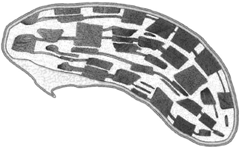Chloroplasts
Nearly all life on Earth runs on sunlight and, thus, depends on the processes that occur in chloroplasts. It is therefore fitting that these structures be examined in depth.The most significant distinction between animal cells and plant cells is the presence of chloroplasts in plant cells. Under a light microscope, chloroplasts appear as uniformly
 |
| Figure 2-10 Under low magnification a chloroplast appears uniformly green. High magnification (a) however, reveals that the chlorophisy liln discrete bodies, called grana, which are surrounded by a clear stroma. Higher magnification (b) reveals that the chlorophyll is arranged in a lamellar fashion. |
Examination under an electron microscope reveals that chlorophyll is not uniformly dispersed in the chloroplast; rather, chlorophyll is concentrated in grana suspended in a clear stroma. The stroma contains protein. The chloroplast possesses a double-membrane structuresi milar to that of mitochondria, except that the inner membrane is not folded as it is in mitochondria. When grana are further magnified, it becomes apparent that chlorophyll is contained in compressed stacks of paired lamellae. These disc-like lamellae are called thylakoids. (Thylakos is a Greek word for “sac.”) Grana are interconnected by fret membranes. The arrangement of chlorophyll in the structure of the lamel lae is important to the chlorophyll’s capacity to carry on photosynthesis.
Chlorophyll is linked to proteins, and the resemblance of chlorophyll’s molecular structure to that of hemoglobin is remarkable. One significant difference between the two types of molecules is found at the centers of the molecules. A chlorophyll molecule possesses an atom of magnesium, while a hemoglobin molecule contains an atom of iron. There are several variations on the molecular structure of chlorophyll, the different forms being found in different groups of plants. All photosynthetic organisms (except several forms of bacteria) have chlorophyll
a. Flowering plants have two forms of chlorophyll: chlorophyll a and chlorophyll
b. Certain algae have chlorophylls
c and d. Photosynthetic bacteria have their own type of chlorophyll.
 |
Figure 2-11 A chloroplast from a ceollf Zea mays (corn). The grana are distinct and appear to be constructed of a stack of lamellae, or thylakoids. The grana are interconnected by extensions of the lamellae |
Chloroplasts contain their own DNA and thus are able to make a number of their own components. Chloroplasts divide independently of the cells in which they reside, although the first formed chloroplasts arise from proplastids. Chloroplasts are not, however, totally autonomous; some of their components are supplied by the cell.
There are some interesting speculations regarding the origin of chloroplasts. As was mentioned earlier, Professor Lynn Margulis of Boston University proposes that eukaryotic cells arose from prokaryotic cells by invasion, or endosymbiosis. According to this theory, nuclei had their origins through a prokaryote entering another prokaryote and taking up residence there. The same reasoning has been applied to the origin of chloroplasts; that is, that they entered cells by being ingested. A number of researchers have voiced objection to this theory, however. While nuclei, chloroplasts, and mitochondria are all double membraned structures and all contain their own DNA, they do greatly different things. For this reason some researchers believe that these structures came about through evolutionary trends rather than through ingestion.




